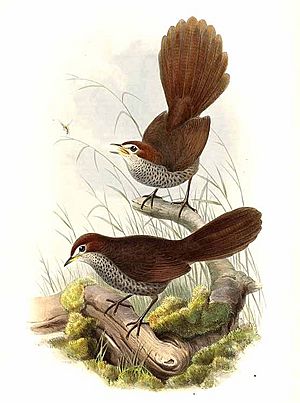Western rufous bristlebird facts for kids
Quick facts for kids Western rufous bristlebird |
|
|---|---|
 |
|
| Conservation status | |
| Scientific classification |
|
| Kingdom: | Animalia |
| Phylum: | Chordata |
| Class: | Aves |
| Order: | Passeriformes |
| Family: | Dasyornithidae |
| Genus: | Dasyornis |
| Species: | |
| Subspecies: |
D. b. litoralis
|
| Trinomial name | |
| Dasyornis broadbenti litoralis (Milligan, 1902)
|
|
| Synonyms | |
|
|
The western rufous bristlebird (Dasyornis broadbenti litoralis) was a special type of rufous bristlebird. It was also known by other names like the south-western rufous bristlebird. This bird used to live only in Western Australia. Sadly, it is now extinct, which means there are no more of these birds left in the world.
Contents
Why Did This Bird Disappear?
This bristlebird was first discovered on October 12, 1901. A scientist named Alexander William Milligan found it near Margaret River. He collected an adult female bird and described it as a new species the next year.
The last time anyone reliably saw this bird was in 1908. After that, there were a few unconfirmed sightings, but they were not proven. Because of this, the western rufous bristlebird is officially listed as extinct in Australia.
Scientists believe the main reason it disappeared was because its home was destroyed. Its habitat, which was a type of shrubland, was often burned in the early 1900s. These fires were started to clear land for pasture, which is land used for animals to graze.
Where Did It Live?
The western rufous bristlebird lived in a very small area. It was found only along about 50 kilometers of the coast. This area was between Cape Naturaliste and Cape Mentelle in south-western Australia.
It preferred to live in thick, short shrubland. This type of plant life grew on cliffs and sand dunes near the ocean.
What Did It Look Like?
The bristlebird was a lot like a thrush, which is another type of bird. It spent most of its time on the ground. It had short, rounded wings and was about 25 to 27 centimeters long.
Its head had a rich reddish-brown cap that went down to its ears. Its face was off-white, and its chin, throat, and chest were grey-white with bold, wavy patterns.
The back of its neck, its back, and its upper tail were reddish-brown. This color changed to olive brown on its lower back. Its upper wings were brown, and most of its underside was grey. Its beak was grey-black, becoming lighter grey or pink on the bottom part. It had red eyes and brown legs and feet.
What Did It Eat?
When the first specimen was studied, scientists looked at what was in its stomach. They found that it had eaten only land snails. This suggests that snails were a very important part of its diet.
What Did It Sound Like?
Alexander William Milligan, the person who discovered the bird, wrote about its calls. He said it had two different sounds. One was an alarm call that sounded like pink-pink-pink. The other was a series of clear, beautiful notes, much like a thrush.


